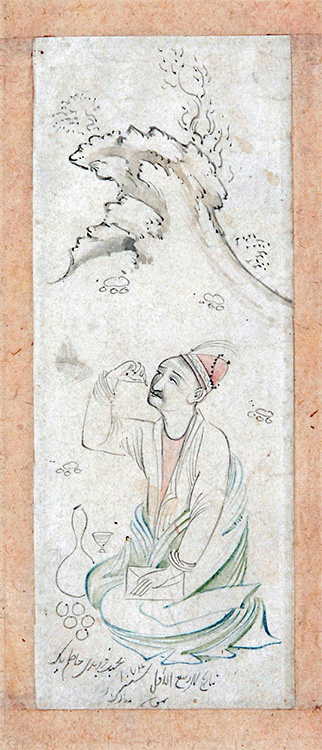Moʿin Moṣavver | Individual Drawings and Paintings
Drawing 1663.1
Darvish Seated Eating Fruit
Location: Toronto, Aga Khan Museum, AKM 451. Formerly in the Collection of Prince Sadruddin Aga Khan, Ir.M.45.
Tinted Drawing: (H x W) Drawing 14.8 x 5.4 cm. Leaf 27.8 x 17.5 cm.
Signature: Unsigned but dated 1074/1663.
Inscription
At the bottom: betāriḵ-e šahr-e rabiʿ al-avval sana 1074 bejehat-e farzandi ḥāṭem beg naqqaš šod. mobārak bād. Translation: “Painted in the month of Rabiʿ I of the year 1074/October 1663 for Ḥāṭem Beg who is like a son to me. May he be blessed.” The inscription is not signed but appears to be in Moʿin’s handwriting.
Description:
A darvish sits in the lower portion of the drawing, facing the left. In his left hand he holds a book or envelope against his knee, and with his right hand raises a small fruit above his lips. He wears a long white robe that folds under him, and a conical cap. A summarily drawn wine bottle, a cup, and five pieces of fruit lie at his right knee. A craggy rock formation with two sketchily drawn trees rise in the background. The darvish’s cap and undershirt are accented in red wash; the remainder of the drawing is monochromatic with slight hints of blue and green.
Bibliography:
Rabino, PC_1916, p.48.
Wiet, EP_1933, p.85, no.XXVII and pl.XXXIX right.
BWG_1933, no.373b.
Robinson, CB_1960, Vol II, no.265 iii.
Stchoukine, SA_1964, p.71.
Welch, AK4_1978, p.215, Ir.M.45.
Commentary:
The inscription states that the drawing is for Ḥāṭem Beg, and it would not be a stretch to assume that he is also the subject of the drawing. The inscription goes on to refer to Ḥāṭem Beg as a farzandi, that is to say someone who is "like a son" to the artist; Farzand would be used when referring to ones actual son, farzandi would be a friend who is so close to be considered almost like a son. All of the authors cited above attribute this drawing to Moʿin, with the exceptions of Stchoukine, who rejects the attribution, and Welch, who makes no attribution at all. In this case it would seem that Stchoukine is unjustified in his criticism. The inscription, although unsigned, appears to be very much in Moʿin’s handwriting. The pose is one that found frequent favor in Moʿin’s repertoire (cf. 1650.3 and 1660.1; the craggy rock formations with summarily treated shrubs stylized in similar fashion appears in the background of many of Moʿin’s manuscript paintings (cf. Mss.C, f.133), but the most tell-tale characteristic of the master’s hand is the drooping eyelids (cf. 1672.1)
Photo courtesy of The Aga Khan Museum. Copyright © 2018 The Aga Khan Museum.
Robert Eng
Last Updated: November 19, 2018 | Originally published: November 19, 2018
Drawing 1663.1
Darvish Seated Eating Fruit
Location: Toronto, Aga Khan Museum, AKM 451. Formerly in the Collection of Prince Sadruddin Aga Khan, Ir.M.45.
Tinted Drawing: (H x W) Drawing 14.8 x 5.4 cm. Leaf 27.8 x 17.5 cm.
Signature: Unsigned but dated 1074/1663.
Inscription
At the bottom: betāriḵ-e šahr-e rabiʿ al-avval sana 1074 bejehat-e farzandi ḥāṭem beg naqqaš šod. mobārak bād. Translation: “Painted in the month of Rabiʿ I of the year 1074/October 1663 for Ḥāṭem Beg who is like a son to me. May he be blessed.” The inscription is not signed but appears to be in Moʿin’s handwriting.
Description:
A darvish sits in the lower portion of the drawing, facing the left. In his left hand he holds a book or envelope against his knee, and with his right hand raises a small fruit above his lips. He wears a long white robe that folds under him, and a conical cap. A summarily drawn wine bottle, a cup, and five pieces of fruit lie at his right knee. A craggy rock formation with two sketchily drawn trees rise in the background. The darvish’s cap and undershirt are accented in red wash; the remainder of the drawing is monochromatic with slight hints of blue and green.
Bibliography:
Rabino, PC_1916, p.48.
Wiet, EP_1933, p.85, no.XXVII and pl.XXXIX right.
BWG_1933, no.373b.
Robinson, CB_1960, Vol II, no.265 iii.
Stchoukine, SA_1964, p.71.
Welch, AK4_1978, p.215, Ir.M.45.
Commentary:
The inscription states that the drawing is for Ḥāṭem Beg, and it would not be a stretch to assume that he is also the subject of the drawing. The inscription goes on to refer to Ḥāṭem Beg as a farzandi, that is to say someone who is "like a son" to the artist; Farzand would be used when referring to ones actual son, farzandi would be a friend who is so close to be considered almost like a son. All of the authors cited above attribute this drawing to Moʿin, with the exceptions of Stchoukine, who rejects the attribution, and Welch, who makes no attribution at all. In this case it would seem that Stchoukine is unjustified in his criticism. The inscription, although unsigned, appears to be very much in Moʿin’s handwriting. The pose is one that found frequent favor in Moʿin’s repertoire (cf. 1650.3 and 1660.1; the craggy rock formations with summarily treated shrubs stylized in similar fashion appears in the background of many of Moʿin’s manuscript paintings (cf. Mss.C, f.133), but the most tell-tale characteristic of the master’s hand is the drooping eyelids (cf. 1672.1)
Photo courtesy of The Aga Khan Museum. Copyright © 2018 The Aga Khan Museum.
Robert Eng
Last Updated: November 19, 2018 | Originally published: November 19, 2018
